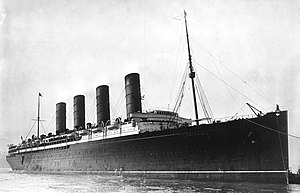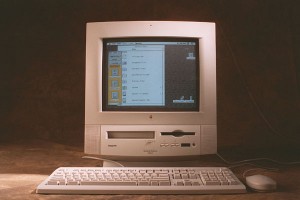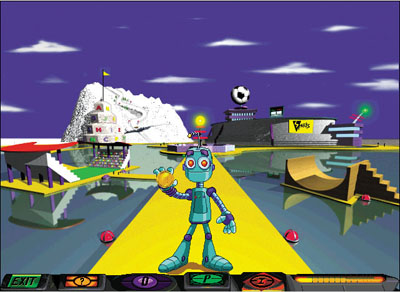This is a summary of “Engadget Primed: SSDs and you,” the “going further” reading from November 7th, when we talked about hardware enhancements. Although the main focus of the article was on modern advances in solid state storage, it started by chronicling previous important developments in the history of data storage. The article is very lengthy, so I’ve tried to summarize it as briefly as I can while still getting the important points, but this post will be a long one.
One of the first systems it mentioned was IBM’s RAMAC, which we also discussed in class. The system included IBM’s first disk storage unit, with a whopping storage capacity of 4.4 MB. We’ve come a long way, in an era where a 60GB disk is considered tiny, and 1TB is par for the course.
After recounting the early players in mechanical storage, the article goes on to explain the technology behind modern mechanical drives like the ones still in predominant usage today. Surprisingly, at its roots the technology is barely different from that in the first IBM hard drives. A hard drive has one or more spinning magnetic platters. Bits (0’s and 1’s) are recorded based on how each magnetic grain is polarized. The primary difference between early rotary hard drives and newer models is the speed at which they rotate (the IBM 350 spun at 1200RPM, modern hard drives typically spin at 7400 RPM), and most importantly, the data density. There is a limit to how much data can physically be stored in a given area of a magnetic disk though:
Eventually, though, magnetic storage runs into fundamental laws of physics. In this case, those immutable rules are represented by the superparamagnetic effect (SPE). Once we shink magnetic grains below a certain threshold, they become susceptible to random thermal variations that can flip their direction.
Essentially, traditional hard drives are physically running out of space to store any more data. Manufacturers have pushed the limits to about 3TB, but at some point, it’s not possible to store more data without drastically affecting performance.
Finally, after working through the background information, the article delves into SSDs and how they work. I’ve been using an SSD for about 6 months now, and had read some articles about them previously, but hadn’t learned about the inner workings in nearly this much detail. I suggest you read the article, because I can’t possibly fit all of the details into this space, but here’s an overview.
So how does flash work, and what makes it different from traditional magnetic drives? The short answer is that instead of storing data magnetically, flash uses electrons to indicate ones and zeroes. You might already recognize why this is a plus: no moving parts. That means no noise, no head crashes, and greater energy efficiency since you don’t have to move a mechanical arm. And unlike DRAM, it’s non-volatile — it doesn’t need constant power to retain information.
Non-magnetic storage has actually existed for many years, and has previously been used in specialized applications such as space probes and data acquisition systems for oil exploration. The first consumer-targeted flash storage for use as a storage disk on a regular computer showed up around 2005 in a Samsung laptop. With 32GB of flash storage, the laptop cost almost $4000. If you thought SSDs are expensive now, think again.
The article goes on to explain in-depth how the underlying physics of solid state storage work. To summarize a few of the most interesting points:
- There are two types of flash memory: SLC and MLC (single level cell and multi level cell). MLC memory can store twice as much data in a given amount of space, but takes longer to read and write. MLC also degrades faster.
- SSDs slow down over time as they fill up with data. This has to do with how the memory cells are wear leveled and how data is actually written to the SSD. Some SSDs actually ship with extra space built in (which is used by the device but not reported to the operating system) to account for this.
- SSDs wear out relatively quickly. Most MLC-based flash has a limit of around 100,000 cycles. This limit can be reached in as little as a year. An article on Coding Horror about the hot/crazy scale of SSDs recounts numerous SSD failures, with none lasting more than 2 years.
- SSDs are more power efficient than HDDs because they have no moving parts
- The controller chip being used has a huge impact on performance. Early SSD controller were often low-quality, resulting in poor performance and longevity.
SSDs are still a rapidly evolving technologies. Just recently have prices started to come down into the $1/GB range. As the technology advances, it will become increasingly affordable – right now, SSDs are primarily used by developers, gamers, and other power users, but they are starting to make their way into the mainstream, especially when integrated with consumer products like tablets and ultralight laptops. The big question that remains is, are they worth it?
In my view, not quite yet. As the price continues to drop, SSDs will soon reach the point where they are economically feasible for everyone, but presently, it’s impractical to store large amounts of data on them. A popular choice right now is to have a relatively small (60-160GB) SSD with boot files, applications, and some working data on it, and a secondary mechanical hard drive to store large files for which transfer speed is less important. This is a challenge in laptops though, where space is at a premium and it’s often difficult to fit both a hard drive and solid state drive into one machine. The solution I use is an optical bay caddy: I’ve removed the DVD burner from my laptop, and put a hard drive caddy in its place. I have a 128GB SSD as my primary drive, and store large files on the hard drive. Some laptops are now shipping with a hard drive and a small SSD both built in, as well.
Solid state storage is a fascinating technology, both for its physical underpinnings and the effects it’s having on the computing industry. I foresee a time in the near future when SSDs will be standard fare, and we will all wonder how we lived without them. For those of us who’ve already had a taste, that question has already presented itself.








 One of the biggest ways that computers and the internet in particular have influenced me is with the ability to collaborate with, meet, and learn from other people. I had my first experience with online forums while trying to figure out how to modify the login screen on my laptop. After getting my question figured out, I ended up sticking around and learning more about computers than I had anywhere else previously. I spent some time editing on Wikipedia, before getting tired of the intense bureaucracy there.
One of the biggest ways that computers and the internet in particular have influenced me is with the ability to collaborate with, meet, and learn from other people. I had my first experience with online forums while trying to figure out how to modify the login screen on my laptop. After getting my question figured out, I ended up sticking around and learning more about computers than I had anywhere else previously. I spent some time editing on Wikipedia, before getting tired of the intense bureaucracy there. 
 Most moderation is done by regular users, although there are a handful of community moderators. In another unique twist, moderators are elected by a democratic voting system, not appointed by site admins. I was elected to be a moderator this spring, and am still actively involved on the site. In an increasingly interconnected world, it’s important to recognize the worldviews, lifestyles, and perspectives of people from other cultures. I talk with a programmer in the Netherlands. I read essays from students researching biodiesel in Brazil. I’ve made friends with a deaf diabetic from the midwest. The internet was founded on the basis of spreading knowledge and connecting the world, and I feel privileged to have taken a part in that experience.
Most moderation is done by regular users, although there are a handful of community moderators. In another unique twist, moderators are elected by a democratic voting system, not appointed by site admins. I was elected to be a moderator this spring, and am still actively involved on the site. In an increasingly interconnected world, it’s important to recognize the worldviews, lifestyles, and perspectives of people from other cultures. I talk with a programmer in the Netherlands. I read essays from students researching biodiesel in Brazil. I’ve made friends with a deaf diabetic from the midwest. The internet was founded on the basis of spreading knowledge and connecting the world, and I feel privileged to have taken a part in that experience.